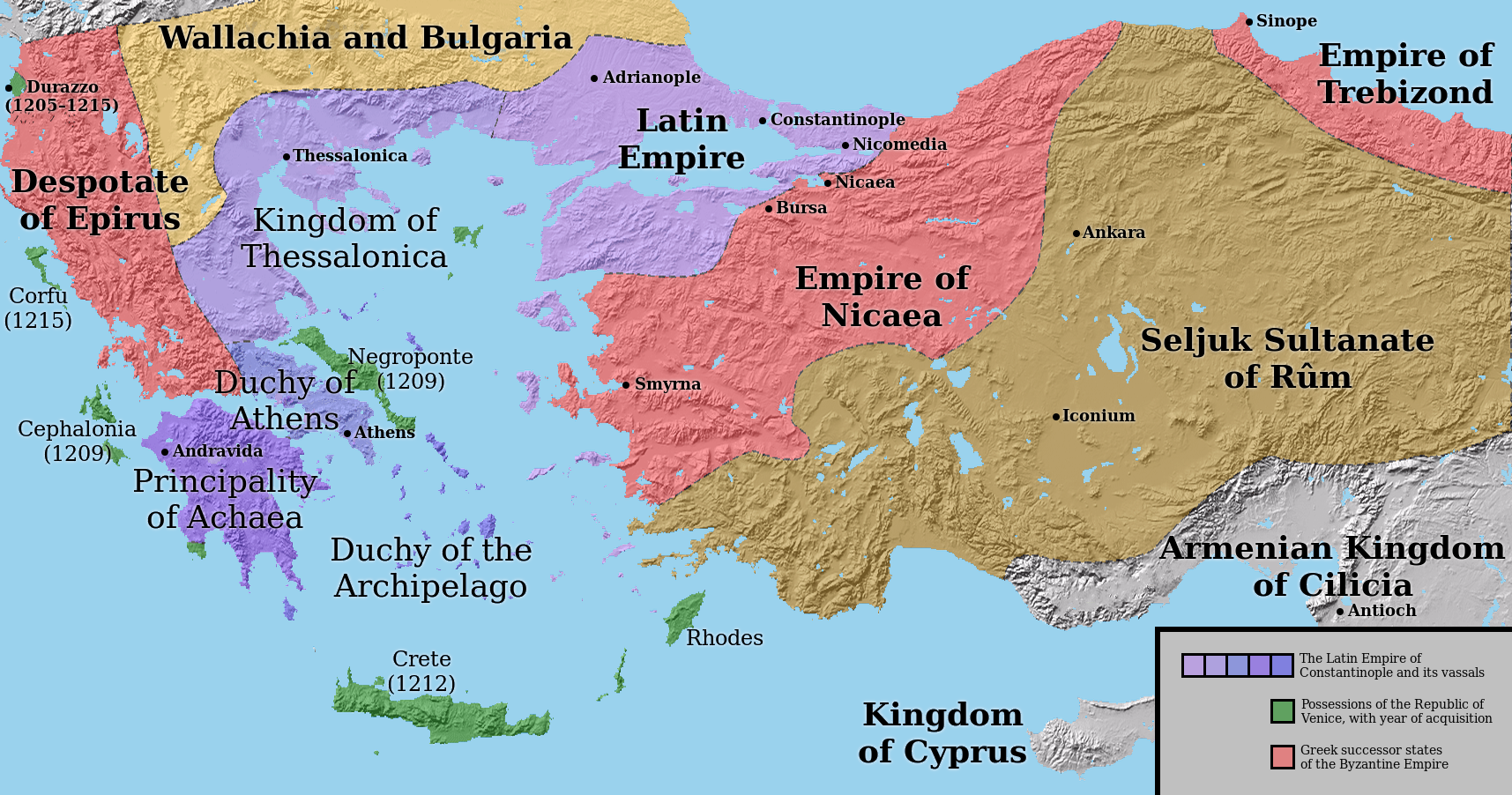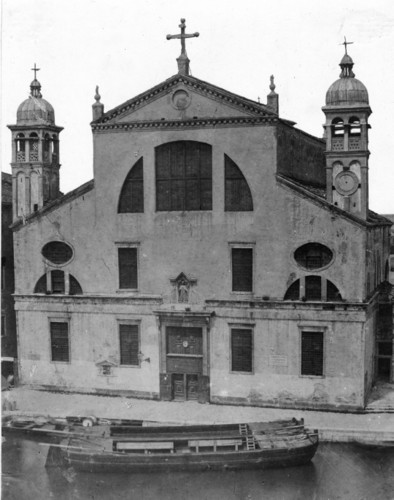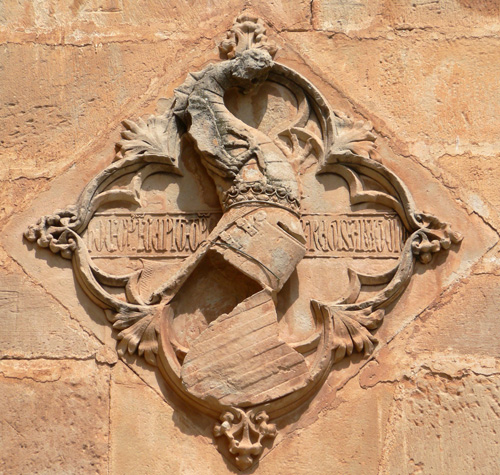|
Pietro Cornaro
Pietro Cornaro, also known as Peter Cornaro or Corner (died in 1387 or 1388), was Lord of Argos and Nauplia in Frankish Greece from 1377. Early life Pietro was the son of Federico Cornaro of the Santa Lucia branch. He was born before 1363. Being one of the wealthiest Venetian patricians of his age, Federigo could afford to conduct his own foreign policy. Historian Anthony Luttrell proposes that Federigo arranged Pietro's marriage with Maria of Enghien, Lady of Argos and Nauplia, in 1377 most probably because he wanted to establish a commercial basis in the Peloponnese. The Senate of Venice authorized him on 16 July 1377 to arm a galley and to transport Maria to Venice. Lord of Argos and Nauplia Pietro's marriage with Maria made him her co-ruler in 1377, but he was still young. His father took care of the defense of Argos and Nauplia and sent supplies to the two towns in 1378. Federigo also bought a galley to defend the lordship against pirates in 1381. Heavy taxation during th ... [...More Info...] [...Related Items...] OR: [Wikipedia] [Google] [Baidu] |
Lordship Of Argos And Nauplia
During the late Middle Ages, the two cities of Argos (, ) and Nauplia (modern Nafplio, Ναύπλιο; in the Middle Ages Ἀνάπλι, in French ''Naples de Romanie'') formed a lordship within the Frankish-ruled Morea in southern Greece. Following their conquest in 1211–1212, the cities were granted as a fief to Otto de la Roche, duke of Athens, by Geoffrey I of Villehardouin, prince of Achaea. The lordship remained in the possession of the de la Roche and the Brienne dukes of Athens even after the conquest of the Duchy of Athens by the Catalan Company in 1311, and the Brienne line continued to be recognized as dukes of Athens there. Walter VI of Brienne was largely an absentee lord, spending most of his life in his European domains, except for a failed attempt in 1331 to recover Athens from the Catalans. After his death in 1356 the lordship was inherited by his sixth son, Guy of Enghien. Guy took up residence in Greece, and in 1370–1371 Guy and his brothers launched ... [...More Info...] [...Related Items...] OR: [Wikipedia] [Google] [Baidu] |
Frankish Greece
The Frankish Occupation (; anglicized as ), also known as the Latin Occupation () and, for the Venetian domains, Venetian Occupation (), was the period in Greek history after the Fourth Crusade (1204), when a number of primarily French and Italian states were established by the on the territory of the partitioned Byzantine Empire. The terms and derive from the name given by the Orthodox Greeks to the Western French and Italians who originated from territories that once belonged to the Frankish Empire, as this was the political entity that ruled much of the former Western Roman Empire after the collapse of Roman authority and power. The span of the period differs by region: the political situation proved highly volatile, as the Frankish states fragmented and changed hands, and the Greek successor states re-conquered many areas. With the exception of the Ionian Islands and some islands or forts which remained in Venetian hands until the turn of the 19th century, the ... [...More Info...] [...Related Items...] OR: [Wikipedia] [Google] [Baidu] |
Federico Cornaro (14th Century)
Federico Cornaro or Corner (died 1382) was a 14th-century Venetian patrician, merchant and politician. In 1379, he was accounted the richest man in Venice, having become wealthy from his sugar plantations in Cyprus. He used this wealth to buy his son a marriage with the heiress of the Lordship of Argos and Nauplia in Greece, which he ''de facto'' ruled in their name until his death. Relations with the Kingdom of Cyprus The exact date of his birth and his early career are unknown, and difficult to reconstruct due to the presence of namesake figures of the wider House of Cornaro at the same time. Around the middle of the 14th century, he bought the palazzo now known as the Ca' Loredan, which today houses the municipal council of Venice. There he hosted Albert III, Duke of Austria during his visit in 1361, as well as King Peter I of Cyprus a short while after. The latter event resulted in a close relationship between the two men. Federico received lands and honours—membership in ... [...More Info...] [...Related Items...] OR: [Wikipedia] [Google] [Baidu] |
Santa Lucia, Venice
Santa Lucia was a church in Venice, northern Italy, which was demolished in 1861. History According to Jacopo Sansovino, the church was founded in 1192 as a local parish dedicated to the Annunciation of Mary. According to the tradition, it changed name in 1279 after the drowning of some pilgrims going to venerate the body of St. Lucy, stolen by the Republic of Venice, Venetians in the Sack of Constantinople (1204), Sack of Constantinople during the Fourth Crusade and then in the island of San Giorgio Maggiore. It was thus decided to move the corpse to the church in the main island of Venice. In 1580, just before his death, Andrea Palladio had executed some drawings for a renovation of the interior, although the church was finished 30 years after and thus his intervention is disputed/ In 1806, after the Napoleonic invasion of northern Italy, the nuns then holding the church and its convent were expelled. In 1860, when the city was connected to the mainland's railway, the complex ... [...More Info...] [...Related Items...] OR: [Wikipedia] [Google] [Baidu] |
Maria Of Enghien
Maria of Enghien, also known as Marie of Enghien or d'Enghien (after 1363–1392/1393), was the Lady of Argos and Nauplia in Frankish Greece from 1376 or 1377 to 1388. Because she was a minor when she inherited the lordship from her father, Guy of Enghien, his brother, Louis of Enghien, was appointed to be her guardian. Louis gave Maria in marriage to a Venetian patrician, Pietro Cornaro, in 1377. Maria moved to Venice, but she was involved in the administration of her lordship. After her husband died, she sold the lordship to the Republic of Venice for a regular income in 1388. Early life Maria was born after 1363 to Guy of Enghien, Lord of Argos and Nauplia, and Bonne de Foucherolles. Being her parents' only child, she was the heiress apparent to her father's lordship when she was engaged to Joan de Lluria, the Catalan lord of Stiris in the Duchy of Athens in 1371. Although the marriage project was confirmed in the last months of the year, it was never concluded. Lady ... [...More Info...] [...Related Items...] OR: [Wikipedia] [Google] [Baidu] |
Peloponnese
The Peloponnese ( ), Peloponnesus ( ; , ) or Morea (; ) is a peninsula and geographic region in Southern Greece, and the southernmost region of the Balkans. It is connected to the central part of the country by the Isthmus of Corinth land bridge which separates the Gulf of Corinth from the Saronic Gulf. From the late Middle Ages until the 19th century, the peninsula was known as the Morea, a name still in colloquial use in its demotic form. The peninsula is divided among three administrative regions: most belongs to the Peloponnese region, with smaller parts belonging to the West Greece and Attica regions. Geography The Peloponnese is a peninsula located at the southern tip of the mainland, in area, and constitutes the southernmost part of mainland Greece. It is connected to the mainland by the Isthmus of Corinth, where the Corinth Canal was constructed in 1893. However, it is also connected to the mainland by several bridges across the canal, including two submers ... [...More Info...] [...Related Items...] OR: [Wikipedia] [Google] [Baidu] |
War Of Chioggia
The War of Chioggia () was a conflict fought by the Republic of Genoa against the Republic of Venice between 1378 and 1381, the conclusion of an open confrontation that had lasted for years and which had already included some occasional and limited military clashes. Initially the Genoese managed to conquer Chioggia and vast areas of the Venetian Lagoon, but in the end the Venetians managed to recover Chioggia and the Lagoon and Istrian cities that had fallen into the hands of the Genoese. The war then ended diplomatically with the Treaty of Turin on 8 August 1381, which sanctioned the exit of the Genoese and Venetians from a conflict in which both maritime republics had suffered enormous economic damage. The War of Chioggia represented the last major clash between the Genoese and the Venetians, from which Venice soon recovered thanks to its solid internal organisation, while Genoa, at that time also tormented by internal struggles for power, entered a period of clashes which led ... [...More Info...] [...Related Items...] OR: [Wikipedia] [Google] [Baidu] |
Peter IV Of Aragon
Peter IV (Catalan: ''Pere IV d'Aragó;'' Aragonese; ''Pero IV d'Aragón;'' 5 September 1319 – 6 January 1387), called the Ceremonious (Catalan: ''El Cerimoniós''; Aragonese: ''el Ceremonioso''), was from 1336 until his death the king of Aragon, king of Sardinia and Corsica, Sardinia-Corsica, and King of Valencia, Valencia, and count of Barcelona. In 1344, he deposed James III of Majorca and made himself King of Majorca. His reign was occupied with attempts to strengthen the crown against the Union of Aragon and other such devices of the nobility, with their near constant revolts, and with foreign wars, in Sardinia, Sicily, the Mezzogiorno, Latin Empire, Greece, and the Balearics. His wars in Greece made him Duke of Athens and Duchy of Neopatria, Neopatria in 1381. Succession conflicts Peter was born at Balaguer, the eldest son and heir of Alfonso IV of Aragon, Alfons IV, then Count of Urgell, and his first wife, Teresa d'Entença. Peter was designated to inherit all of ... [...More Info...] [...Related Items...] OR: [Wikipedia] [Google] [Baidu] |
Duchy Of Athens
The Duchy of Athens (Greek language, Greek: Δουκᾶτον Ἀθηνῶν, ''Doukaton Athinon''; Catalan language, Catalan: ''Ducat d'Atenes'') was one of the Crusader states set up in Greece after the conquest of the Byzantine Empire during the Fourth Crusade as part of the process known as Frankokratia, encompassing the regions of Attica and Boeotia, and surviving until its conquest by the Ottoman Empire in the 15th century. History Establishment of the Duchy The first duke of Athens (as well as of Thebes (Greece), Thebes, at first) was Otto de la Roche, a minor Duchy of Burgundy, Burgundian knight of the Fourth Crusade. Although he was known as the "Duke of Athens" from the foundation of the duchy in 1205, the title did not become official until 1260. Instead, Otto proclaimed himself "Lord of Athens" (in Latin language, Latin ''Dominus Athenarum'', in French language, French ''Sire d'Athenes''). The local Greeks called the dukes "Megas Kyris" (, "Great Lord"), from which ... [...More Info...] [...Related Items...] OR: [Wikipedia] [Google] [Baidu] |
Lords Of Argos And Nauplia
Lords may refer to: * The plural of Lord Places *Lords Creek, a stream in New Hanover County, North Carolina *Lord's, English Cricket Ground and home of Marylebone Cricket Club and Middlesex County Cricket Club People *Traci Lords (born 1968), American actress Politics *House of Lords, upper house of the British parliament *Lords Spiritual, clergymen of the House of Lords *Lords Temporal, secular members of the House of Lords *Trịnh Lords, Vietnamese rulers (1553–1789) Other *Lords Feoffees, English charitable trust *Lords of Acid, electronic band *Lords Hoese, English noble house *''Lords of the Realm'', ''Lords of the Realm II'', and ''Lords of the Realm III'', a series of video games *"Lords", a song by the Sword from the album ''Gods of the Earth'' See also * Lord (other) * House of Lords (other) The House of Lords is the upper house of the Parliament of the United Kingdom. House of Lords may also refer to: Upper houses * Irish Hou ... [...More Info...] [...Related Items...] OR: [Wikipedia] [Google] [Baidu] |
House Of Cornaro
The House of Cornaro or Corner were a Venetian patrician family in the Republic of Venice and included many Doges and other high officials. The name ''Corner'', originally from the Venetian dialect, was adopted in the eighteenth century. The older standard Italian ''Cornaro'' is no longer common in Italian sources referring to earlier members of the family, but remains so in English. History The family and name Cornaro are said to descend from the gens Cornelia, a patrician family of Ancient Rome. The Cornari were among the twelve tribunal families of the Republic of Venice and provided founding members of the Great Council in 1172. In the 14th century, the family separated into two distinct branches, Cornaro of the Great House and Cornaro Piscopia. The latter name derived from the 1363 grant of the fief of Piscopia in the Kingdom of Cyprus to Federico Cornaro. When Caterina Cornaro married king James II of Cyprus in 1468, the Lusignan royal arms were added to the fami ... [...More Info...] [...Related Items...] OR: [Wikipedia] [Google] [Baidu] |
1380s Deaths
138 may refer to: *138 (number) *138 BC *AD 138 *138 (New Jersey bus) *138 Tolosa 138 Tolosa is a brightly coloured, stony background asteroid from the inner region of the asteroid belt. It was discovered by French astronomer Henri Joseph Perrotin on 19 May 1874, and named by the Latin and Occitan name ( and ) of the Frenc ..., a main-belt asteroid * Tatra 138, a heavy truck {{numberdis ... [...More Info...] [...Related Items...] OR: [Wikipedia] [Google] [Baidu] |




